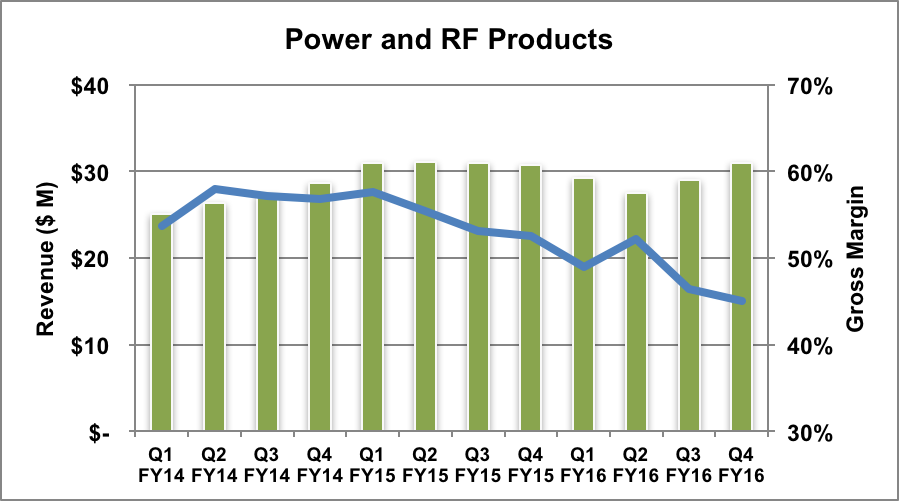Here's a summary of the industry news that caught my attention last week.
Companies and Products
Analog Devices (ADI) reported Q3 fiscal 2016 revenue of $870 million, a sequential increase of 12 percent and 1 percent above last year's quarter. Demand from aerospace and defense customers was weaker than expected, attributed to the timing of orders. Communications segment revenue was $174 million, down 1 percent sequentially, yet 23 percent above last year's quarter.

During ADI's earnings call, an analyst asked about the outlook for the communications infrastructure segment, given the softness in the quarter and guidance for that to continue. Listen to the response by CEO Vincent Roche:
Another analyst asked for an update on the Hittite acquisition, which closed two years ago (on July 22, 2014). Listen to the company's response, first by CFO Dave Zinsner, followed by Vincent Roche:
Custom MMIC, a fabless MMIC supplier birthed from Hittite's successful business model, is celebrating their 10th anniversary. As the MMIC industry consolidates, the privately held firm has established a performance-based niche in an increasingly mass market.
Fairview Microwave released three coaxial, bidirectional amplifiers covering 1.35 to 1.39 and 2.4 to 2.5 GHz, with a wideband model from 30 MHz to 3 GHz. The amplifiers are designed for commercial and military applications and support any signal type and modulation format. The switching time between transmit and receive paths is typically 1 µs.
Intel held its developer forum last week, sharing its strategic intent to shift from the core PC and server businesses to new beachheads in IoT, wireless and AI. Among the announcements the company made: volume shipment of silicon photonics transceivers for data centers, in PSM4 and CWDM4 configurations. Intel has successfully integrated III-V lasers and detectors with their CMOS process — and doing so in a way that scales to volume production. There's more information in this LightReading interview with Intel VP Alexis Black Bjorlin.
Keysight Technologies reported Q3 fiscal 2016 revenue of $718 million, 8 percent above the prior year's quarter. Behind the numbers, the communications market, Europe and Russia were soft. The outlook for Q4 is for revenue to decline 3 percent below the prior year's period, to between $715 million and $755 million.
 |
 |
National Instruments introduced LabVIEW Communications System Design Suite 2.0, for prototyping wireless systems like 5G and 802.11. The software aids developing real-time algorithms that will run on the NI Linux Real-Time operating system.
POET Technologies demonstrated an HFET fabricated with their externally fabbed, III-V optoelectronic process. They now have two of the three basic building blocks required for optoelectronic transceivers. The remaining hurdle is the VCSEL, which they hope to demonstrate within months. The company is pursuing active optical cables (AOC) for data centers, the same market Intel is targeting.
Cree reported Q4 and fiscal year results for their power and RF products segment, rebranded as Wolfspeed and being acquired by Infineon. Full-year revenue was $117 million, a decline of 6 percent from fiscal 2015. Gross margin was 48 percent, down $12 million from fiscal 2015.

Markets and Technology
Cellular/5G — Zahid Ghadialy, author of The 3G4G Blog, posted an informative update on the features in 3GPP's Release 14 (LTE) and the status of Release 15 (the first 5G release).
China Mobile and Ericsson demonstrated a 5G mission-critical use case using a drone flying across multiple cell sites that were carrying regular mobile phone traffic.
China's most recent quarterly smartphone sales data paints a picture of a fierce and tumultuous market, where becoming the market leader seems like drinking from a poison chalice.
Broadband — Alphabet, the parent of Google Fiber, is rethinking its strategy for delivering broadband. Given the cost and time required to deploy fiber, wireless technology may now have the performance to be competitive. Will the third time — remember LMDS and WiMAX — be the charm?
Autonomous Driving — Uber is testing 100 "autonomous" Volvos in Pittsburgh. The car will "drive" itself with a "driver" as backup. Read The Wall Street Journal article.
If you come across news that you think is worth including in the weekly report, please send it to me at glerude@mwjournal.com. Your feedback about content is always welcome.

